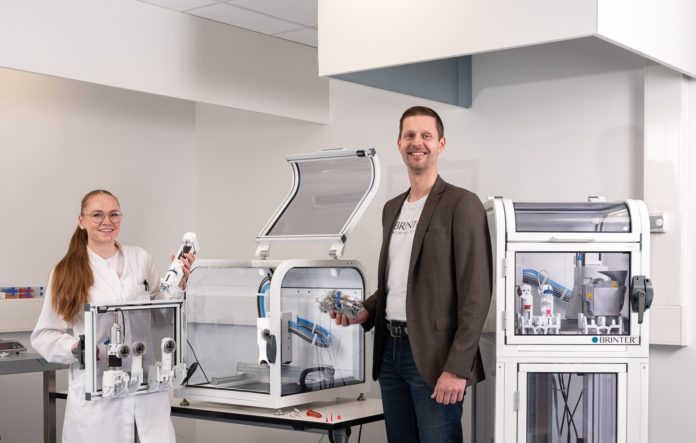Brinter, a Finland-based 3D bioprinting company that recently secured a financing round, announces the launch of an entry-level 3D printer.
Named Brinter Core, the new release ambitions to expand the use of the company’s multi-material 3D bioprinting technology within the research and manufacturing fields. Designed to be easily portable, it is half the cost of its predecessor.
Brinter Core can print multi-material and highly complex tissue structures in 3D, both stiff and soft materials, including but not limited to liquids and hydrogels with living cells, bio-paste, metal with binder material, and plastic while being easy to pack up and set up in a different lab or cleanroom in minutes.
“We really want to open up the 3D bioprinting market in a way that’s never been done before,” says Brinter CEO Tomi Kalpio. “Researchers and companies need to deliver products for 3d bioprinting, but many don’t have 3d printers with unlimited bioinks and other materials yet due to their significant cost and difficulty moving them between labs. With the Brinter Core, we make 3D bioprinting a reality and get started for those that previously were boxed out of the market,” he continues.
The benefits of 3D bioprinting range from cancer research to printing human “spare parts” such as kidneys, hearts, or even brains. The company aims to help save more lives through more personalized treatment. For example, researchers can print 3D cancerous cells and track how they communicate with each other, allowing researchers to identify the best individual drugs to treat the disease.
Brinter Core performs many of the same functions as its predecessor, using the same printing heads, meaning upgrades are available if required. They are easily swapped between Brinter products without any tools. Available printing technologies include, for example, valve-free pneumatic extrusion (Pneuma Tool), screw-driven mechanical extrusion, i.e. endless piston pump (Visco Tool), solenoid-driven dispensing (MicroDroplet Tool), and thermoplastic granulate extrusion (Granu Tool).
“Medical research facilities and universities often still rely on traditional methods of discovery in the research of new drugs, understanding diseases, and finding medical ways to help people. Drug developers are excited to get their hands on the device to do fast prototyping and testing and deliver treatments that save more lives,” says Pirkko Härkönen, Counsellor, Institute of Biomedicine, MD, PhD, Professor emer.
Remember, you can post job opportunities in the AM Industry on 3D ADEPT Media free of charge or look for a job via our job board. Make sure to follow us on our social networks and subscribe to our weekly newsletter: Facebook, Twitter, LinkedIn & Instagram ! If you want to be featured in the next issue of our digital magazine or if you hear a story that needs to be heard, make sure you send it to contact@3dadept.com






